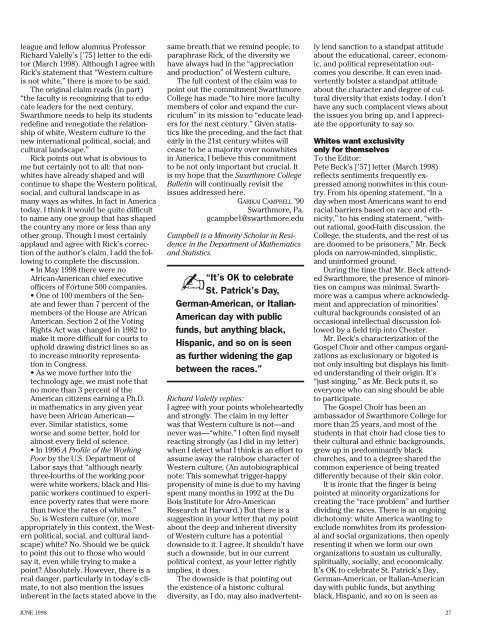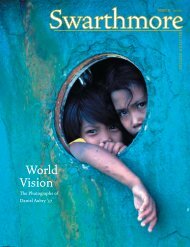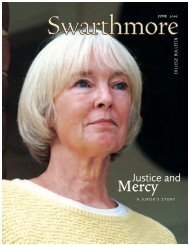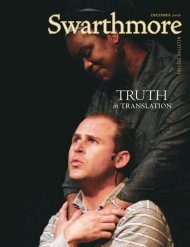Swarthmore College Bulletin (June 1998) - ITS
Swarthmore College Bulletin (June 1998) - ITS
Swarthmore College Bulletin (June 1998) - ITS
- No tags were found...
Create successful ePaper yourself
Turn your PDF publications into a flip-book with our unique Google optimized e-Paper software.
league and fellow alumnus ProfessorRichard Valelly’s [’75] letter to the editor(March <strong>1998</strong>). Although I agree withRick’s statement that “Western cultureis not white,” there is more to be said.The original claim reads (in part)“the faculty is recognizing that to educateleaders for the next century,<strong>Swarthmore</strong> needs to help its studentsredefine and renegotiate the relationshipof white, Western culture to thenew international political, social, andcultural landscape.”Rick points out what is obvious tome but certainly not to all: that nonwhiteshave already shaped and willcontinue to shape the Western political,social, and cultural landscape in asmany ways as whites. In fact in Americatoday, I think it would be quite difficultto name any one group that has shapedthe country any more or less than anyother group. Though I most certainlyapplaud and agree with Rick’s correctionof the author’s claim, I add the followingto complete the discussion.• In May <strong>1998</strong> there were noAfrican-American chief executiveofficers of Fortune 500 companies.• One of 100 members of the Senateand fewer than 7 percent of themembers of the House are AfricanAmerican. Section 2 of the VotingRights Act was changed in 1982 tomake it more difficult for courts touphold drawing district lines so asto increase minority representationin Congress.• As we move further into thetechnology age, we must note thatno more than 3 percent of theAmerican citizens earning a Ph.D.in mathematics in any given yearhave been African American—ever. Similar statistics, someworse and some better, hold foralmost every field of science.• In 1996 A Profile of the WorkingPoor by the U.S. Department ofLabor says that “although nearlythree-fourths of the working poorwere white workers, black and Hispanicworkers continued to experiencepoverty rates that were morethan twice the rates of whites.”So, is Western culture (or, moreappropriately in this context, the Westernpolitical, social, and cultural landscape)white? No. Should we be quickto point this out to those who wouldsay it, even while trying to make apoint? Absolutely. However, there is areal danger, particularly in today’s climate,to not also mention the issuesinherent in the facts stated above in thesame breath that we remind people, toparaphrase Rick, of the diversity wehave always had in the “appreciationand production” of Western culture.The full context of the claim was topoint out the commitment <strong>Swarthmore</strong><strong>College</strong> has made “to hire more facultymembers of color and expand the curriculum”in its mission to “educate leadersfor the next century.” Given statisticslike the preceding, and the fact thatearly in the 21st century whites willcease to be a majority over nonwhitesin America, I believe this commitmentto be not only important but crucial. Itis my hope that the <strong>Swarthmore</strong> <strong>College</strong><strong>Bulletin</strong> will continually revisit theissues addressed here.GARIKAI CAMPBELL ’90<strong>Swarthmore</strong>, Pa.gcampbe1@swarthmore.eduCampbell is a Minority Scholar in Residencein the Department of Mathematicsand Statistics.✍“It’sOK to celebrateSt. Patrick’s Day,German-American, or Italian-American day with publicfunds, but anything black,Hispanic, and so on is seenas further widening the gapbetween the races.”Richard Valelly replies:I agree with your points wholeheartedlyand strongly. The claim in my letterwas that Western culture is not—andnever was—“white.” I often find myselfreacting strongly (as I did in my letter)when I detect what I think is an effort toassume away the rainbow character ofWestern culture. (An autobiographicalnote: This somewhat trigger-happypropensity of mine is due to my havingspent many months in 1992 at the DuBois Institute for Afro-AmericanResearch at Harvard.) But there is asuggestion in your letter that my pointabout the deep and inherent diversityof Western culture has a potentialdownside to it. I agree. It shouldn’t havesuch a downside, but in our currentpolitical context, as your letter rightlyimplies, it does.The downside is that pointing outthe existence of a historic culturaldiversity, as I do, may also inadvertentlylend sanction to a standpat attitudeabout the educational, career, economic,and political representation outcomesyou describe. It can even inadvertentlybolster a standpat attitudeabout the character and degree of culturaldiversity that exists today. I don’thave any such complacent views aboutthe issues you bring up, and I appreciatethe opportunity to say so.Whites want exclusivityonly for themselvesTo the Editor:Pete Beck’s [’57] letter (March <strong>1998</strong>)reflects sentiments frequently expressedamong nonwhites in this country.From his opening statement, “In aday when most Americans want to endracial barriers based on race and ethnicity,”to his ending statement, “withoutrational, good-faith discussion, the<strong>College</strong>, the students, and the rest of usare doomed to be prisoners,” Mr. Beckplods on narrow-minded, simplistic,and uninformed ground.During the time that Mr. Beck attended<strong>Swarthmore</strong>, the presence of minoritieson campus was minimal. <strong>Swarthmore</strong>was a campus where acknowledgmentand appreciation of minorities’cultural backgrounds consisted of anoccasional intellectual discussion followedby a field trip into Chester.Mr. Beck’s characterization of theGospel Choir and other campus organizationsas exclusionary or bigoted isnot only insulting but displays his limitedunderstanding of their origin. It’s“just singing,” as Mr. Beck puts it, soeveryone who can sing should be ableto participate.The Gospel Choir has been anambassador of <strong>Swarthmore</strong> <strong>College</strong> formore than 25 years, and most of thestudents in that choir had close ties totheir cultural and ethnic backgrounds,grew up in predominantly blackchurches, and to a degree shared thecommon experience of being treateddifferently because of their skin color.It is ironic that the finger is beingpointed at minority organizations forcreating the “race problem” and furtherdividing the races. There is an ongoingdichotomy: white America wanting toexclude nonwhites from its professionaland social organizations, then openlyresenting it when we form our ownorganizations to sustain us culturally,spiritually, socially, and economically.It’s OK to celebrate St. Patrick’s Day,German-American, or Italian-Americanday with public funds, but anythingblack, Hispanic, and so on is seen asJUNE <strong>1998</strong> 27
















